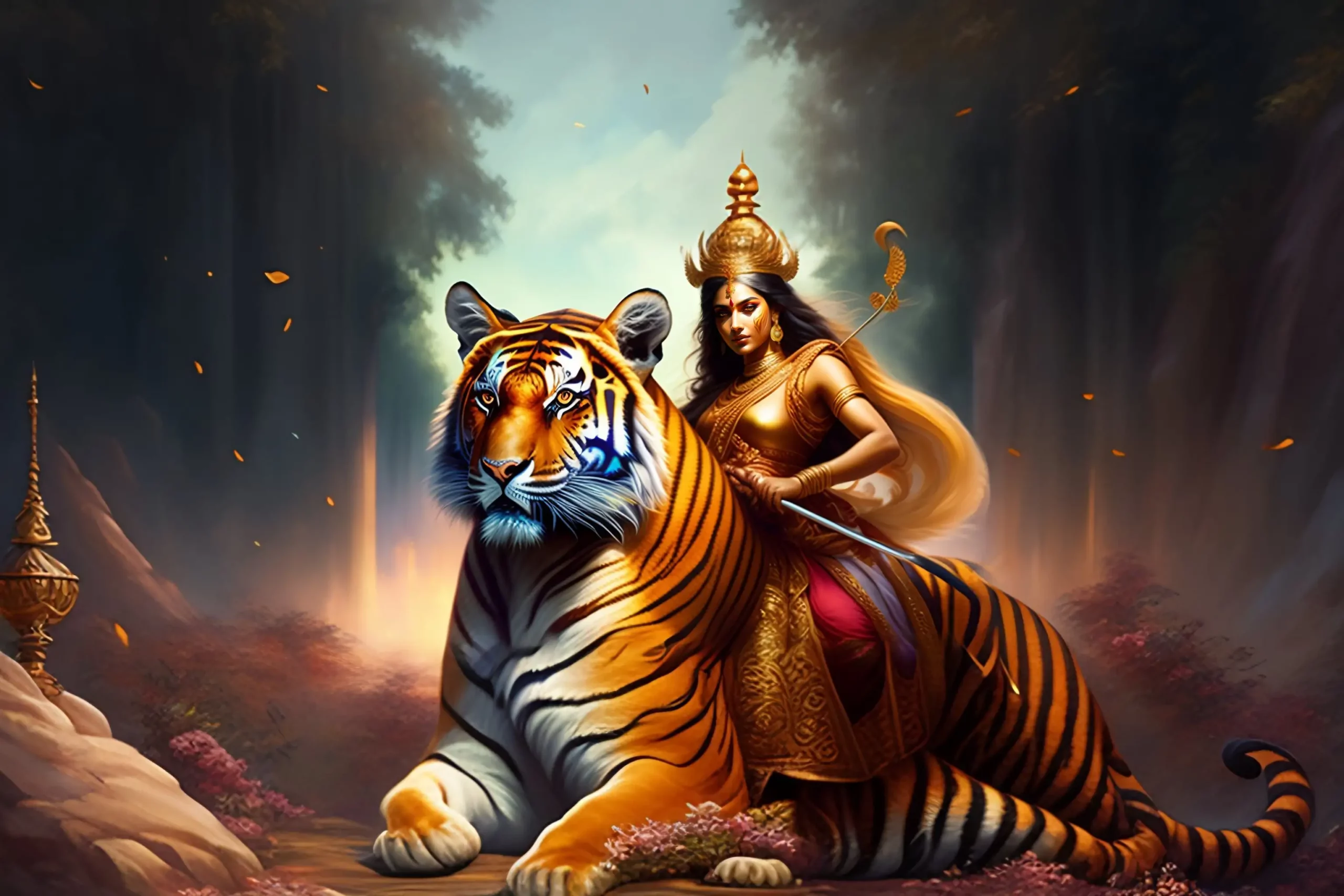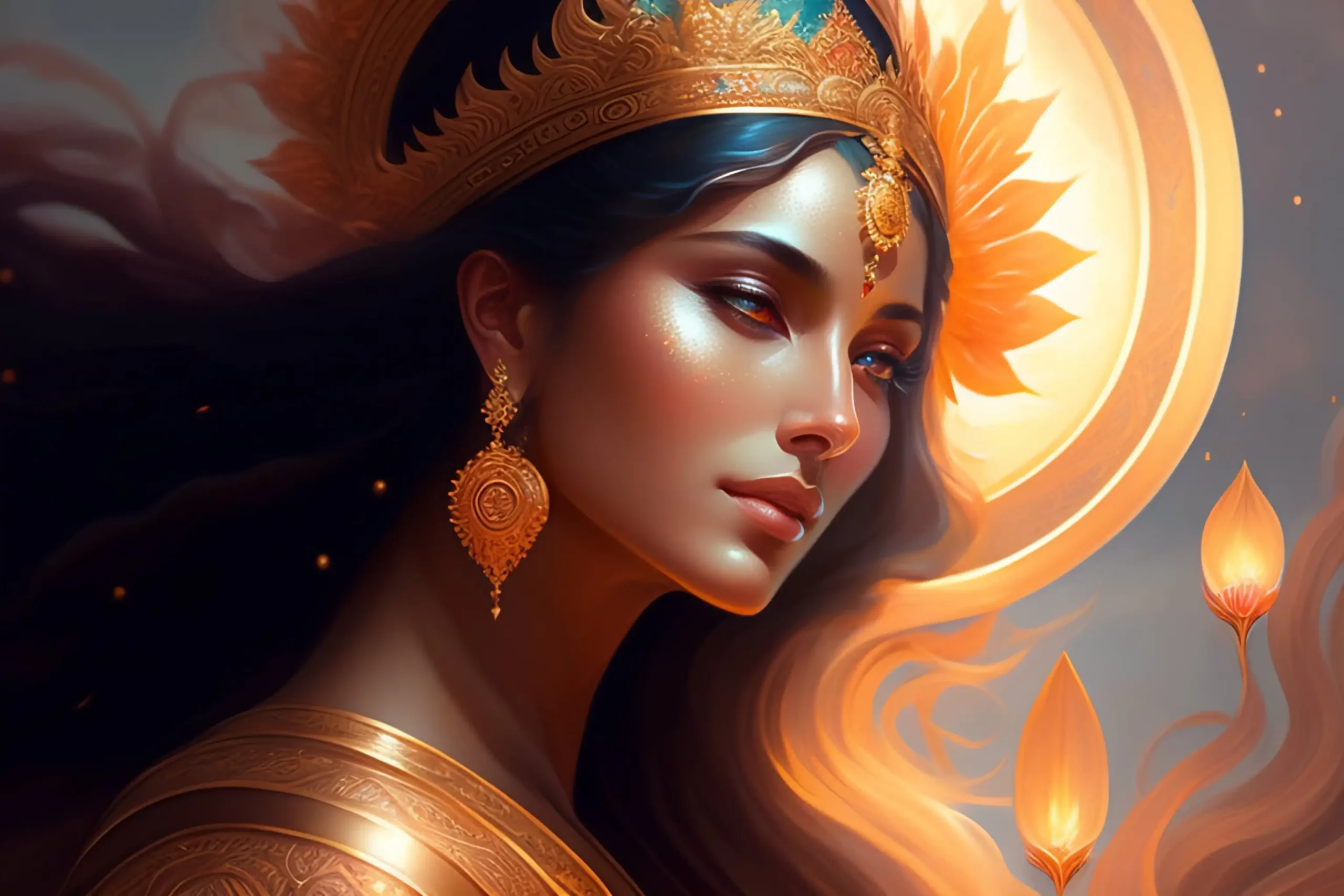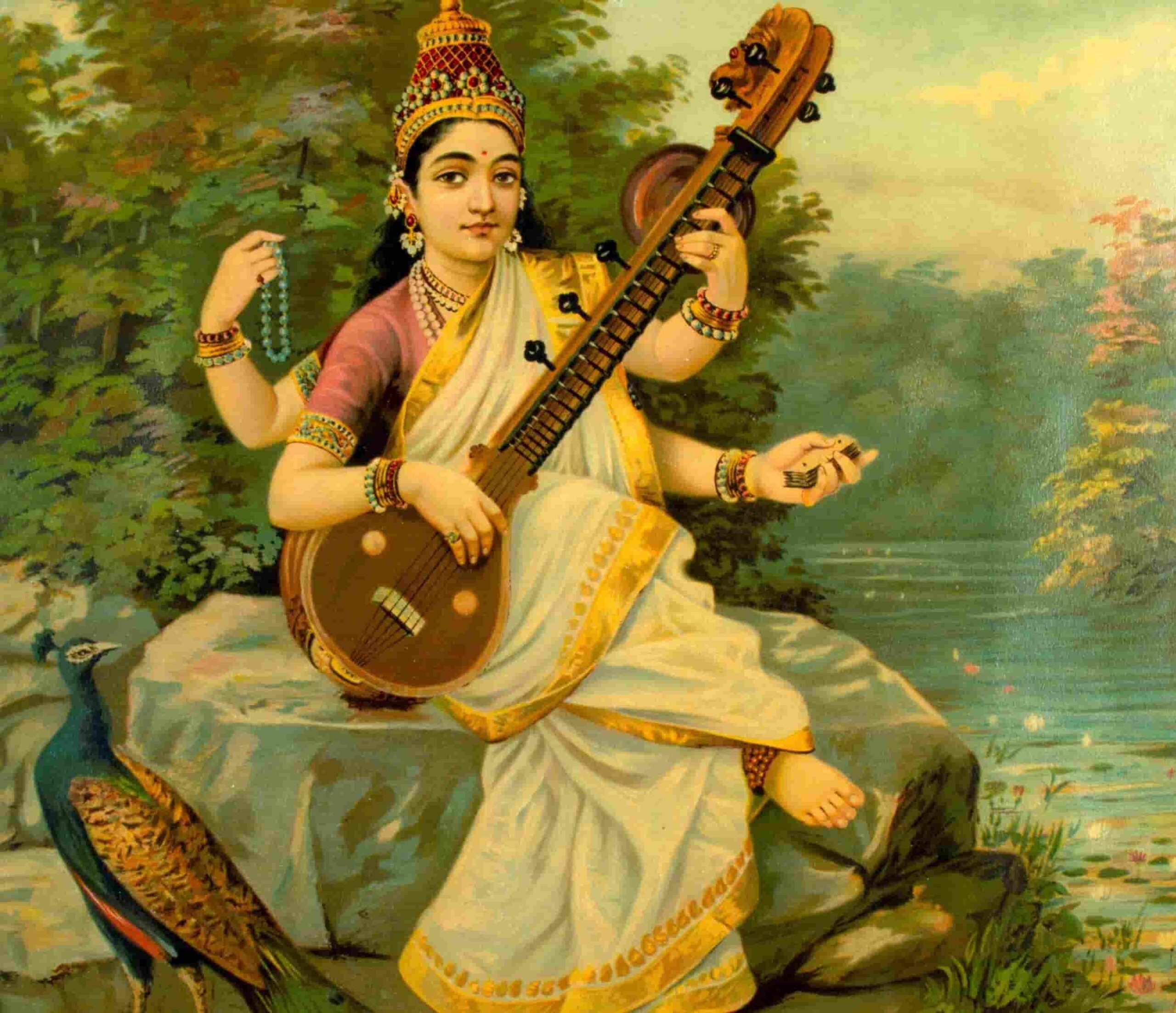Goddess Parvati is revered as the embodiment of beauty, grace, and life preservation, as well as the very incarnation of Shakti. She is widely regarded as the epitome of an “Ideal Woman” in society, representing a vast array of exemplary virtues. Like the setting sun, her beauty and grace inspire readers far and wide to embrace values such as love, devotion, loyalty, and faith, which have helped shape our civilization. Through her divine qualities, Parvati serves as a powerful example of the importance of living a virtuous life.

(Public Domain)
Who Is Parvati?
Parvati is one of the Hindu Tridevi Goddesses, along with Lakshmi and Saraswati. She is revered as the divine Goddess of fertility, beauty, love, and marriage. Endearingly referred to as the “Mother Goddess,” Parvati is the consort and eternal wife of Lord Shiva – The God of Destruction, and mother of Lord Ganesha – The destroyer of all obstacles.
Throughout her life, Parvati fiercely protected her young with undying rage and determination, taking pride in her evergreen marriage and family. As a gentle manifestation of Adi-Shakti – the divine feminine energy that defines the universe, Parvati boasts immense strength and power while maintaining her benevolent and nurturing nature, a testament to her role as the “Mother of the Universe.”
As one of the most ancient Devis, Parvati is widely worshipped in the Hindu sect of Shaktism as the eternal feminine energy in which the “Divine Goddess” is considered the Supreme Godhead and the originator of the Universe.
Goddess Parvati is the embodiment of womanhood, brimming with intense emotions from impeccable rage to eternal benevolence. Throughout her life, she has taken numerous powerful forms ranging from Durga, the warrior Goddess, to Kali, the Goddess of Destruction. These forms of Parvati are called the Mahavidhyas and serve as a reminder of her power and the many facets of femininity.
Epithets: Different Names Of Parvati
Goddess Parvati is known by a plethora of different names, each exemplifying one of her many qualities. The name Parvati itself is derived from the Sanskrit word “Parvata,” which translates to “mountain.” Parvati is the daughter of King Himavan, the personification of the Himalayas, hence earning her name.
- Narayani
Goddess Parvati is often revered as the cosmic sibling of Lord Vishnu – The preserver of the Universe. Lord Vishnu, in his celestial form, is commonly referred to as “Narayana,” and hence, Parvati is called Narayani.
- Gauri
One day, Lord Shiva, Parvati’s husband, referred to her as the “Dark-skinned one.” Offended by this comment, Parvati immediately began to conduct pujas and austerities to lose her dark complexion. Eventually, her wish was fulfilled as she started to shed her dark skin, revealing fair and glowing skin underneath, earning her the name Gauri, the Sanskrit word meaning “Fair One.”
- Maheshwari
The Divine Goddess and Mother of the Universe, Parvati is fondly referred to as Maheshwari, which translates to “Supreme Being of the Universe.”
Origin Story of Parvati
Goddess Parvati is most famously known to be the reincarnation of Sati – Lord Shiva’s first wife. According to Hindu mythology, Sati was the beloved daughter of King Daksha, the son of Lord Brahma. Despite her father’s disapproval, Sati fell in love with Lord Shiva and married him. However, King Daksha was furious about their marriage and held a grand sacrificial ceremony to which he invited all the gods except Lord Shiva. During the ceremony, Daksha insulted Lord Shiva in front of everyone, and unable to bear her father’s disrespect towards her husband, Sati immolated herself in the sacrificial fire.
Upon learning of Sati’s passing, Lord Shiva was utterly devastated and sank into a profound state of mourning. He roamed the earth with Sati’s charred body, unable to let go of his beloved wife. Finally, Lord Vishnu intervened and cut Sati’s body into 51 pieces, which fell to earth as different parts of India.
Sati Reincarnated as Parvati
After Sati’s death, Lord Shiva vowed to never remarry, as he believed she was his eternal love and that no one could ever replace her. Meanwhile, the powerful Asura Taraka was performing penance seeking Lord Brahma’s favor. Impressed by his devotion, Brahma granted Taraka a boon, but Taraka’s initial request for immortality was denied. On his second attempt, he wished for the power to only be defeated by the son of Shiva, knowing that Shiva was still mourning and would not have a son.
Despite sensing Taraka’s true intentions, Brahma granted the boon. As the years went by, Taraka became stronger and terrorized the earth with his army of demons. The residents of the earth prayed to Lord Vishnu for help.
To stop Taraka, Vishnu reincarnated Sati as Parvati, the daughter of King Himavat and Queen Mainavati, who were longing for a daughter that would become Shiva’s consort. Mainavati prayed to Lord Vishnu to bless her with a daughter, and Vishnu granted her request by reincarnating Sati as Parvati.
Iconography: What does Goddess Parvati look like?
Parvati is frequently portrayed as having a fair complexion and a beautiful countenance. She is often depicted wearing a red saree, adorned with garlands, and her long, flowing black hair is also decorated with floral wreaths.
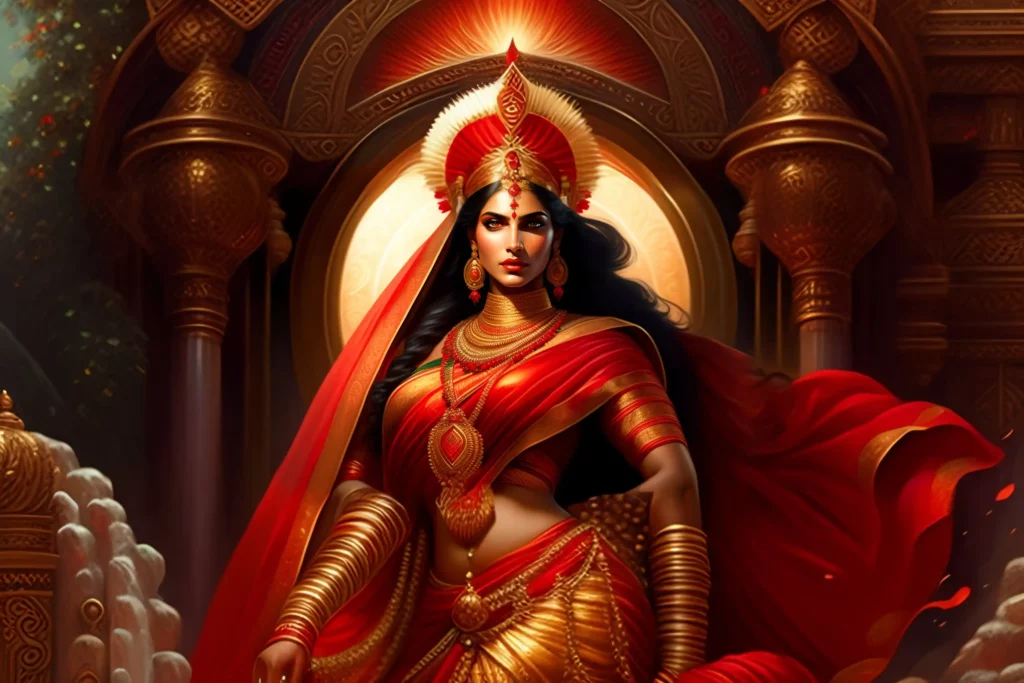
© Vedgyaan.com
Parvati is commonly represented in two forms: the two-armed and four-armed forms. In her two-armed form, she is typically shown standing in the Tribangha pose, with a towering headdress adorned with a halo at the back, and a jeweled belt cinched around her waist, accentuating her feminine figure.
Four-armed depiction
Goddess Parvati is often depicted as a stunningly beautiful woman with four arms in most of her idols and portraits. Each of her arms holds a variety of objects, including a Trident, Mirror, Bell, Vessel, and Flowers. In these depictions, her younger son Lord Ganesha is often seen sitting on her lap, while her elder son Kartikeya plays nearby.
Two-armed depiction
When Goddess Parvati is depicted with two arms, it is said to symbolize a range of divine Mudras or symbolic hand gestures. Her hands typically showcase the Kataka Mudra, which represents enchantment, as well as the Abhaya Mudra, symbolizing fearlessness, and the Varada Mudra, signifying wish fulfillment.
In this form, Parvati’s left hand is often portrayed as showcasing the Varada Mudra, inviting devotees to pray to her to have their deepest desires fulfilled. Her right hand symbolizes the Abhaya Mudra, signifying to her devotees that she will protect them and they need not fear any kind of evil.
Yoni Form
Goddess Parvati is often depicted in the Yoni form. The Yoni is a representation of the womb, signifying Parvati’s crucial role as the Mother of the Universe. This form is known as the Yoni Parvati, and it is considered to be a powerful symbol of fertility and abundance.
Parvati and Shiva
Parvati was born as the daughter of King Himavat and Queen Mainavati. From a young age, she was a devout follower of Lord Shiva and aspired to marry him. However, Lord Shiva was still mourning the death of his previous wife, Sati, and had retreated to a life of meditation and austerity.

(Public Domain)
Undeterred, Parvati resolved to win Lord Shiva’s heart through her own devotion and penance. She spent years meditating and practicing austerities in the forest, enduring harsh conditions and difficult trials. Eventually, her dedication and purity of heart moved Lord Shiva, who agreed to marry her.
The wedding of Shiva and Parvati is celebrated in Hindu tradition as the union of two powerful forces – Shiva, the god of destruction and transformation, and Parvati, the goddess of fertility and devotion. The couple’s union represents the balance of male and female energies in the universe and the cyclical nature of creation and destruction.
In Hindu-Art Parvati is often depicted as a nurturing and compassionate figure, while Shiva is seen as a fierce and powerful deity. However, their union is seen as complementary and necessary for the balance of the cosmos.
The story of Shiva and Parvati has inspired many devotees over the centuries, who see the couple as an example of the power of devotion and the importance of balancing opposing forces in life. Their union represents the ultimate triumph of love and the potential for transformation and growth that lies within each individual.
Ardhanarishvara
Lord Shiva and Parvati are considered the epitome of divine love and devotion. The legend goes that Lord Shiva recognized Parvati as his soulmate, equal in every way, and an integral part of him. He loved her so deeply that she eventually became a part of him, both physically and spiritually.
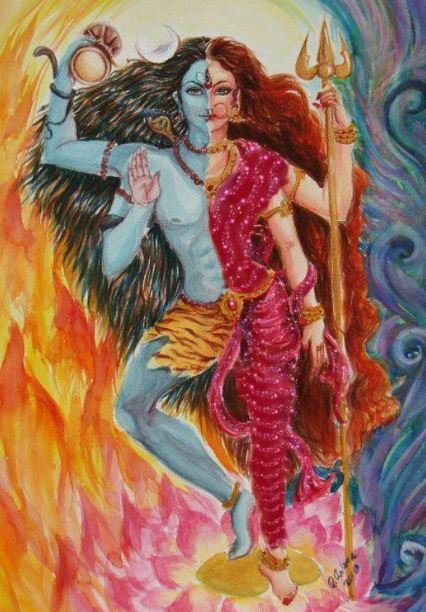
(Public domain)
This union of their souls and bodies resulted in the manifestation of a unique form known as Ardhanarishvara, which translates to “Lord Who Is Half Woman” in Sanskrit.
The Mahavidyas: Manifestations of Goddess Parvati
The Mahavidyas, also known as the “Great Manifestation,” refer to the ten incarnations or aspects of Goddess Parvati. These divine manifestations are revered as goddesses of wisdom, each representing a unique aspect of Parvati’s character. From peaceful and benevolent deities to fierce and formidable warriors, the Mahavidyas embody the vast array of divine qualities that Parvati possesses. The Mahavidyas are often depicted with their own unique iconography and associated mantras, each with its own symbolic meaning and purpose.
The most notable Mahavidyas include the Goddesses Durga, Kali, Tripura Sundari, and Tara.
- Durga
The powerful demon-slaying warrior aspect of Parvati, Durga is known for slaying some of the most formidable demons to have set foot on earth. Durga is worshipped in nine different forms – each form depicting a certain phase in Parvati’s life.
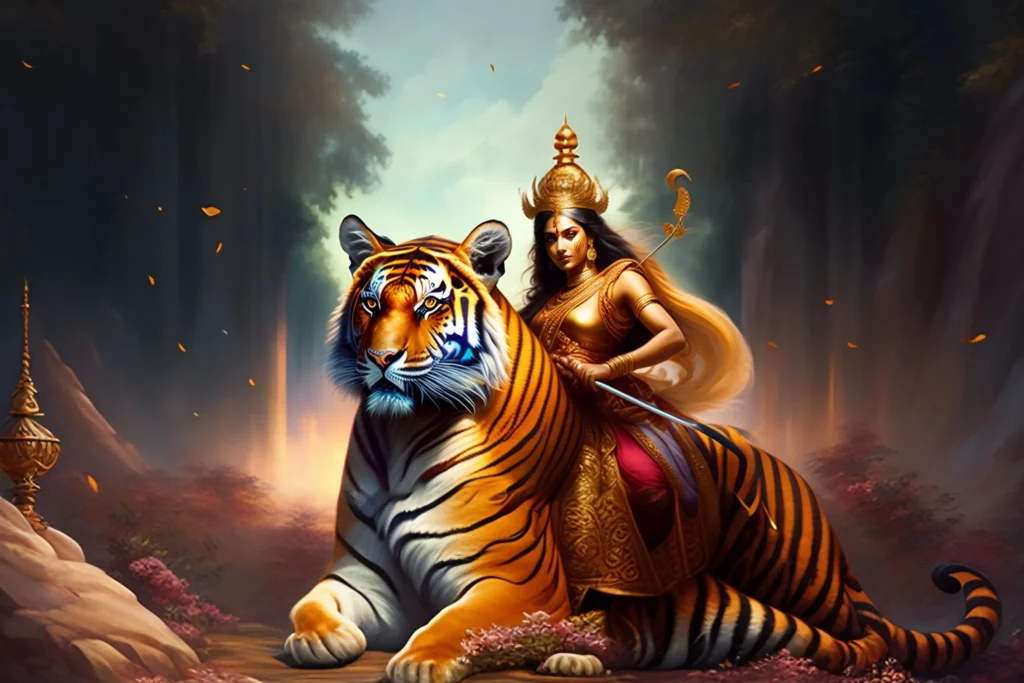
© Vedgyaan.com
- Kali
The terrible and furious Kali is the chief of the Mahavidyas. Kali is the embodiment of Parvati’s rage and is revered as the essence of the Universe or the Supreme Goddess.

(Public Domain)
- Tara
The savior, Tara is the manifestation of Parvati’s nurturing and protective nature. Tara is considered the bestower of knowledge and the ultimate source of salvation.
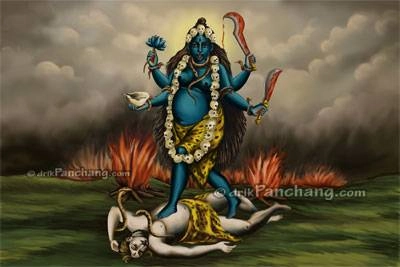
(Public Domain)
Goddess Kali and Tara share many similarities in their appearance. They are both depicted standing upon a supine corpse, which is sometimes identified with Shiva. However, Kali is typically portrayed as black, while Tara is depicted as blue. Both goddesses wear minimal clothing, but Tara wears a skirt made of tiger skin, while Kali wears a girdle of severed human arms. They both adorn themselves with a garland of severed human heads and have a lolling tongue with blood oozing from their mouths. Their appearances are so strikingly alike that it is easy to confuse one for the other.
- Lalita Tripura Sundari
Lalita is considered to be the embodiment of Parvati’s beauty – shockingly beautiful and irresistible to Gods and humans alike. She is fondly referred to as Shodashi, The one who is the most beautiful in the three worlds.
Origin of the Mahavidyas
According to legend, during a playful argument between Parvati and Shiva, Lord Shiva became angry and threatened to leave her. In an effort to stop him, Parvati manifested herself in ten different forms, blocking his path in every direction. Impressed by her love and devotion, Lord Shiva was humbled and the ten forms of Parvati proceeded to enlighten him with truths about the universe, earning his admiration and respect.
These ten forms of Parvati are known as the Mahavidyas, representing various aspects of wisdom and divine qualities.
Parvati’s Significance in Hinduism
Parvati is one of the most significant and widely worshipped Hindu deities and is revered as the Goddess of marriage, fertility, love, and agriculture. She is the archetypal image of motherhood and fertility, and is known for her immense power, will, asceticism, and devotion to one’s spouse.
In Hinduism, Monday is universally accepted as the holy day of Shiva and Parvati. On this day, millions of followers worship Shiva and Parvati together for strength and prosperity. Devotees, especially females, worship Parvati to bless them with marriage, resolve marital conflicts, and fertility. She is also said to grant boons and protection to all of her devotees.
Parvati is considered to be the Mahashakti or the embodiment of the energy of the universe and is, therefore, the source of all life. Worship of Parvati is believed to maintain and protect the universe around her devotees and to bring prosperity into their lives.
Festivals Celebrating Goddess Parvati
Throughout the year, a multitude of Hindu festivals are held in honor of Parvati and her various forms. These celebrations span across different regions and cultures in India, with some of the most notable ones being Navaratri, Gauri Habba, Teej, and more. These festivals serve as an opportunity for devotees to express their reverence and devotion towards Parvati and seek her blessings for their well-being, prosperity, and spiritual growth.
Navaratri
Navaratri is one of the most significant Hindu festivals, celebrated over a period of nine days. Each day of Navaratri is dedicated to worshipping one of the nine forms of Goddess Parvati. The festival is observed in the Hindu calendar month of Ashwin (which overlaps with September and October).
During Navaratri, devotees worship idols and statues of various deities, with special importance given to Durga. They perform a series of pujas and austerities and fast for nine days, seeking the blessings of the Goddess. The festival culminates on the tenth day, known as Dussehra when the statues are immersed in a river body. This marks the end of the festival and heralds the onset of Diwali, the Festival of Lights.
Teej
Teej is an important festival for women followers as it celebrates Goddess Parvati and her strong marital and familial ties, as well as signifying the beginning of the monsoon season. During the festival, married women pray for the long life of their husbands, while unmarried women ask Parvati to bless them with a suitable companion.
Devotees visit Shiva and Parvati temples and make offerings to the Shiva-Lingam. The festival is celebrated with great enthusiasm in Northern and Western India, particularly in Rajasthan, Punjab, and Haryana. Women dress up in bright and colorful traditional clothes, apply henna on their hands and feet, and sing and dance to traditional Teej songs. The festival is also a time for women to take a break from their daily routines and enjoy themselves in the company of their friends and family.
Gauri Habba
Gauri Habba is a festival that honors Parvati’s role as the Goddess of agriculture and harvest, as well as the protector and savior of women. This festival is particularly significant for women, as it is believed to ensure the fertility of the land and the well-being of women. During the festival, women make offerings to the goddess and pray for a good harvest and the prosperity of their families.
Conclusion:
Goddess Parvati holds a significant place in Hindu mythology and is revered for her many virtues and forms. She is worshipped as the embodiment of energy and power, the ultimate source of creation and life. From her fierce warrior form to her gentle and loving motherly form, Parvati’s various manifestations continue to inspire and guide her devotees. Through various festivals and rituals, her devotees continue to seek her blessings for their personal, familial, and societal well-being. Her story and teachings continue to be relevant and hold immense value, not just in the Hindu faith but for all those seeking guidance on love, devotion, strength, and perseverance.


